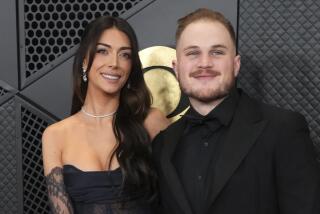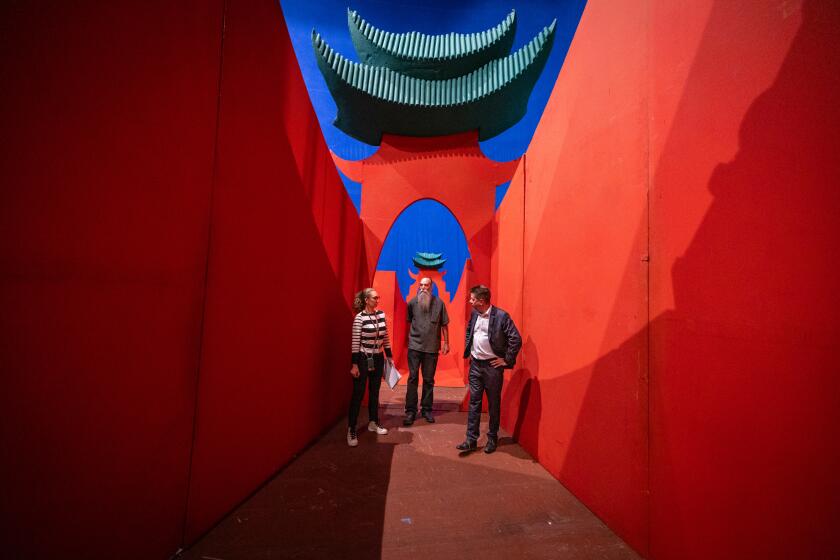For Swiss duo, the charm is in the details
With 11 paintings, a video, more than a dozen small sculptures, five pieces of “furniture,” text inscriptions and two large photographic murals, Andres Lutz and Anders Guggisberg’s sprawling installation at the new Anna Helwing Gallery -- the Swiss pair’s U.S. debut -- is a lot to take in. Rather than dominating viewers, however, the show exerts a gentle draw, unfolding gradually (and generously) with each successive component.
Greeting viewers near the front of the gallery is a small flock of crudely constructed wooden birds, all charred black. A video monitor in their midst issues a slow, haunting score (composed by Guggisberg) and a dreamlike flow of images: a raven perched on a branch; a wooden box in flames on a grass lawn; a grotesquely costumed man leaping eerily in slow motion; and columns of smoke eddying throughout.
Because the audio and visual loops are different lengths (the former about three minutes, the latter nearly 13), the relationship between sound and image is constantly shifting. The swirling effect quickly becomes hypnotic.
Beyond the video, in the larger of the gallery’s two rooms, are several mismatched clusters of dumpster-grade office furniture, arranged according to a seemingly coherent but entirely inscrutable logic. Used packing materials spill from some of the structures like suds from an overloaded washing machine.
One is stuffed with carpet foam. Another -- a mirrored, trough-like enclosure -- is illuminated from within by a rod of fluorescent light.
The charm of the installation lies in its many idiosyncratic details, each of which feels like a private discovery when encountered amid the overall clutter: the desk lamp that emits not light but a conical beam of stone; the several bowls of neatly sorted Styrofoam peanuts; the suggestion, scrawled in marker on one vertical surface, that “a suitable jigsaw and a Jack Daniel dagger would cut us out of this wooden pit.”
One senses, throughout the inscriptions, a good deal of fun being had with the English language, of which neither artist is a native speaker.
The two-dimensional works that line the periphery of the space -- photographs, photographic murals and enamel paintings executed on top of photographs -- are similarly playful in their approach to objects, while also incorporating the surreal quality of the video. A photograph called “The Village” depicts a small community of toy houses and trees nestled among piles of old, wrinkly potatoes, as if among rock formations. In “The Birth of the Century,” the painted image of a sinking ship overlays a photograph of broken chunks of concrete. In “Breadplane,” a winged baguette soars over piles of trash.
After circling the installation once or twice, connections become apparent across media. Images reappear and phrases repeat, weaving through the whole like samples through a piece of music. The entirety thus comes to feel less like a presentation of work than a conversation you happen into mid-stream. Its sprawling quality is less a sign of ambition than a munificent sort of enthusiasm.
Anna Helwing Gallery, 2766 S. La Cienega Blvd., L.A., (310) 202-2213, through Oct. 11. Closed Sundays and Mondays.
*
Ways to engage with the world
“Meeting Places” -- a group show at Gallery 4016 of photographs taken solely with novelty cameras -- feels a little like a well-executed party game, but comes off none the worse for it. The challenge at the root of the project is an interesting one, pointing toward (if not actually addressing) pertinent questions concerning the cultural ubiquity of photography and the relationship between popular and artistic attitudes toward the camera.
The 28 artists who took up the challenge appear to have done so in earnest and generally succeed in crafting quality images, despite the relatively unsophisticated nature of their tools. The best works reveal a genuine attentiveness to the tendencies of a given camera and manage to make use of potential defects (glare, graininess, a limited color spectrum, etc.) rather than succumbing to them.
Among the most interesting are several Polaroid-based collages by Eden Batki; a series of cleverly juxtaposed split-frame snapshots by Cynthia Connolly; a Minimalist arrangement of green (grass) and blue (sky) Polaroids by Karen Velas; a large grid of disorienting abstract images by Ryan Corey; and -- the show’s one conceptual gesture -- a pair of exposed but not yet processed disposable cameras from Laura and Michael Leon, available to the curious viewer for $75 each.
One curious consistency throughout the exhibition -- particularly notable in the works of Paul Redmond, Shelley Pullman, Sam Farfshing, Andy Mueller and Maja D’Aoust -- is a genuine attention to place. Perhaps the show says less about the aesthetic potential of cheap cameras than it does the impulse they inspire to go out and engage with the world.
Gallery 4016, 4016 Santa Monica Blvd., L.A., (323) 660-2920, through Saturday.
*
Amid the rhetoric, some pleasures
As one might well surmise from the trendily enigmatic quality of its title, “Wit Form Rainbow (Part I)” suffers from a dishearteningly vague, if rhetorically elaborate, sense of purpose. The exhibition of mostly abstract painting and sculpture is currently at the Project.
On the level of the work itself, the show certainly has its pleasures. Principal among these are Monique Prieto’s “Warm Body,” a large and characteristically elegant canvas, and two sculptures by Katie Grinnan: a jaunty little swirl of colored plastic called “Light Skid,” and “Jackpot Guitar,” a sprawl of twisted metal that enlivens the gallery’s cavernous space, emanating a soundtrack of slot machines.
The sculptures of John Williams, though comparable in size, lack this intrinsic dynamism and feel inconclusive by comparison. “Puff” -- essentially a 9-by-9-by-7-foot canvas balloon -- is an impressive construction, but with its black and white checkerboard surface, it looks too much like a teenage boy’s canvas tennis shoe to take very seriously.
The smaller, more cerebral paintings of Richard Hawkins also feel adrift here, as though deprived of some essential context. Paired with the murky, unappealing paintings of Steve Canaday, they’re scattered with interesting gestures but never quite take flight.
It’s not clear what exactly these five artists have in common -- or, more important, what they stand to benefit from being shut up in a room together for four weeks. Judging from the strenuously vacuous assertions of the press release, which lauds their ability “to combine the formal language of abstraction with a broad array of contemporary ideologies” and their “involvement in a new kind of experience via new media, contemporary theory and the mixing of high and low culture” -- it seems that the gallery’s not sure either.
The Project, 962-B E. 4th St., downtown L.A., (213) 620-0692, through Oct. 11. Closed Sundays through Tuesdays.
*
Hanging on to sensuous summer
As the heat of summer lingers stubbornly past the theoretical finish line of Labor Day, it seems appropriate that “Sex in Deep Space” -- a wonderfully voluptuous group show at City Gallery in West Hollywood -- -- was extended three weeks past its original closing date. With a cheerful ensemble of beach ball colors and playfully sensual textures, the show embodies just the sort of easy pleasure one tends to associate with the season -- and finds so difficult to abandon come September.
Curated by Marc Arranga and Chip Tom, the show brings together five artists notable for conscientious craftsmanship and a close attention to materials. Diana Cohen, one of the more inspired of those currently working in the trash aesthetic, stitches plastic shopping bags into gorgeous multicolored quilts. Jason Eoff uses resin in his paintings to create smooth, glossy surfaces and a stirring intensity of hue.
Michael Salerno layers color through a sort of speckling process, while David Alan Peters carves into multiple layers of paint to create rainbow-colored pockets of bas relief amid fields of white and black. Barrie Goshko’s images of flowers against vivid backgrounds of yellow, periwinkle and eggplant purple -- the only photographic works in the show -- are erotic without seeming obvious or cheap.
City Gallery, 8444 Melrose Ave., West Hollywood, (323) 658-1085, through Sept. 20. Closed Sundays and Mondays.
More to Read
The biggest entertainment stories
Get our big stories about Hollywood, film, television, music, arts, culture and more right in your inbox as soon as they publish.
You may occasionally receive promotional content from the Los Angeles Times.






